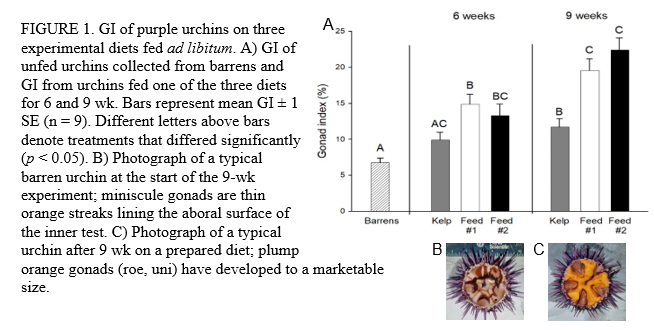ROE ENHANCEMENT OF THE PURPLE SEA URCHIN Strongylocentrotus purpuratus COLLECTED FROM BARREN GROUNDS AND FED PREPARED DIETS
Over the last decade, an overabundance of purple urchins (Strongylocentrotus purpuratus) that exert destructive grazing pressure on essential kelp forest habitat has caused a rapid expansion of barren grounds along the west coast of North America. Although the harvesting of several urchin species has led to high-value fisheries worldwide, purple urchins presently have little to no commercial value, especially in a malnourished, barren condition. Harvesting purple urchins from barrens and enhancing their roe through aquaculture has the potential to transform these destructive grazers into high-quality seafood that also benefits ecological restoration of kelp forests. We collected purple urchins from barrens and fed them whole kelp or two different formulations of prepared feed in a recirculating aquaculture system. The gonad index (GI) of urchins fed the two prepared diets doubled in 6 wk, increased from a barren condition to a marketable yield (GI > 15%) in 9 wk, and was significantly greater than the GI of urchins fed kelp. Analyses of proximate constituents and amino acid composition of gonad tissue also revealed differences among the roe of urchins fed the three diets for 9 wk. In particular, one of the two prepared feeds resulted in a significantly greater amount of bitter-tasting amino acids in enhanced gonads compared to urchins fed whole kelp, while the other prepared formulation indicated a more natural flavor profile. Our results highlight an untapped potential to quickly produce a highly valued seafood product from seemingly low-value purple urchins. Echinoculture could thereby serve as a tool to stimulate urchin industries that also facilitates the restoration of kelp forests from urchin barrens.
